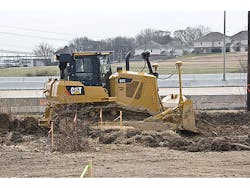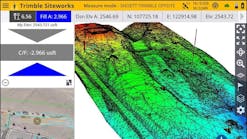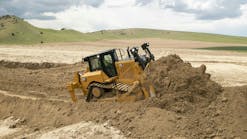Updated 06/26/2009
At the D7E's official introduction event in Peoria, Cat representatives spoke for the first time of the electrically driven bulldozer as a “hybrid-electric” tractor, and candidly discussed the 20-percent premium it is expected to draw over the D7RII it will soon replace. They promised 10 percent better production per hour with 10 to 30 percent lower fuel consumption, but is that enough to outweigh a $600,000 price tag?
Eighteen pre-production D7E hybrid bulldozers built on Caterpillar’s line in East Peoria have amassed thousands of hours in customer operations. Cat expects D7E production to begin in October, with some specialty adaptations (a solid-waste version, for example) to be introduced in spring of 2010. Production of the D7RII is planned to end in the middle of next year.
Caterpillar electric D7E crawler dozer is the first electrically driven dozer using modern alternating-current (AC) technology, and Cat claims it will move up to 25 percent more material per gallon of fuel than the D7R Series II. The drive system takes advantage of today's small, less-costly semiconductors that can rectify heavy-duty-drive voltage to AC, eliminating brushes. The drive is developed by Caterpillar specifically for crawler tractors.
A 235-horsepower Cat C9.3 diesel drives a generator to produce electricity that runs to a power module where it is inverted to AC current. The current powers two AC drive motors arranged in series, which drives a differential steering system much like that used on other Caterpillar dozers.
The electric drive train has 60 percent fewer moving parts than the drive in previous D7s. And because power flows from the generator to the electric drives through cables, rather than a hard drive shaft, the tractor's heaviest components can be positioned optimally in the frame for ideal machine balance.
The C9.3 engine is smaller and achieves rated power at 1,700 rpm, compared to the D7R's 240-horsepower Cat 3176. Smaller displacement is responsible for some of the up-to-20-percent fuel savings, but the biggest efficiency gains come from eliminating the torque converter and keeping the engine running in a much more narrow range of speeds.
The 3176 diesel coupled to a powershift transmission in the D7R normally operates in a speed range from 1,200 to 2,100 rpm, whereas the C9 and electric drive operates more efficiently near peak torque, staying between 1,450 and 1,700 rpm, according to Mike Betz, Caterpillar engineering manager for track-type tractors.
Electric drive eliminates gear shifting, and is said to perform much like a hydrostatic drive, albeit with a much faster response to load demands. Electric-over-hydraulic joysticks control propulsion and blade. Steering performance is improved 50 percent, partly due to use of a dedicated steering pump equal to that used in the D8's differential steering system. With no mechanical link between the D10-sized final drives and the electric motors' refined power, the D7E can lock one track for pivot turns, and even counter-rotate to turn within a diameter no greater than the machine's overall length.
Efficiency is also gained by eliminating parasitic engine load. There are no belts on the Caterpillar electric D7E's engine. The cooling fan is powered by a thermostatically controlled hydraulic motor. (The generator, inverter, and electric motors are liquid cooled.) Twenty-four-volt current is drawn from the generator and diverted to run the water pump, charge the batteries, and power the self-contained air conditioning unit mounted on the cab roof.
"We evaluated all of the current applications for the D7R and purposely set out to build an electric-drive machine that can do all of the same things, and work in all the same environments, that the powershift machine currently can do," says Dave Nicoll, commercial manager in Cat's tractor products department.
Electric-drive components are sealed much the same as Cat seals transmissions and electrical components. Field trials have proven that the system operates reliably submerged to just below the fan, which is as deep as Cat allows any tractor to wade.
Caterpillar turned product developers loose with a clean sheet of paper, so it's no surprise that the differences between the D7E and D7R extend beyond the innovative drive train. Most obvious may be the fact that the D7E crawls with a low-sprocket undercarriage.
"We carefully evaluated all of the kinds of work that a D7 does, and decided the low-drive undercarriage configuration is the best choice for the job," Nicoll explains. "You get the greatest value out of elevated-sprocket undercarriage when it is suspended, and only the D8 and larger sized elevated sprocket undercarriages are suspended. Certainly we will continue to use the elevated-sprocket undercarriage on the D8 and larger tractors."
Nicoll said Cat would rigorously evaluate applications of smaller dozers before it decided whether or not to eliminate elevated sprockets from D6 and smaller units. It's not certain if that question is truly on the table at the moment, but the 2007 introduction of the D6K, bringing an oval-track D6 option back to North America, suggests that Peoria acknowledges demand for broader application of low-drive undercarriage.
Cat also developed a unique center-post cab, which uses a single A post to support the front of the cab and ROPS. The intake pre-cleaner, exhaust stack, and a single, D9-sized, blade-lift cylinder are aligned with the center post. A center mast is available to hold a grade-control receiver (D7E can come from the factory Accugrade-ready or with Accugrade installed). This cleared sight lines to both halves of the blade and allowed the doors to be made wider. Noise at the operator's ear has been cut in half.
Cat retained 500-hour oil-change intervals for the C9.3, but distinguished the D7E by doubling hydraulic-oil change intervals to 2,000 hours and quadrupling drive-train oil changes to 4,000 hours. The D7E marks the first availability of Caterpillar's SystemOne undercarriage on D7-sized tractors. SystemOne has been proving to extend undercarriage life by 35 to 70 percent on smaller tractors for more than three years.
Caterpillar estimates that the D7E, with SystemOne undercarriage, will operate at about 10 percent lower overall lifetime cost than the D7R.
The D7E is expected to be commercially available in 2009. Its production will initiate what Nicoll calls a "ramp-down" of D7R production. Caterpillar intends to replace the R model in North America with the electric-drive innovation.
Just as elevated-sprocket undercarriage debuted on the D7H back in 1977 and spread to other Cat machines, it appears electric drive will migrate into Peoria's extensive machine selection. Electric-drive trucks are almost surely coming, but the technology Cat acquired there is most likely limited to incremental, 3 to 5 percent, efficiency improvements.
Cat believes the greatest opportunities for spreading its newly developed electric-drive technology are on hard-pulling machines that currently use a torque converter. The minds behind the technology hint that there is enormous potential to add batteries (as they improve) and energy regeneration systems to an electric drive train and create ultra-low-emissions hybrid earthmovers in the future.





